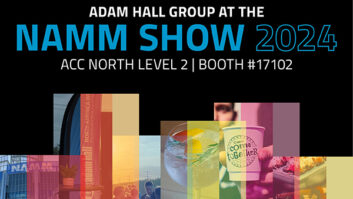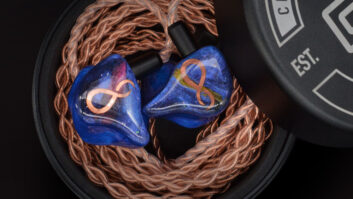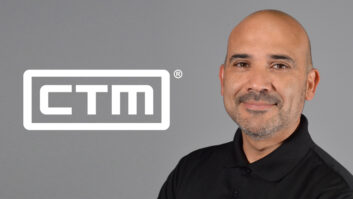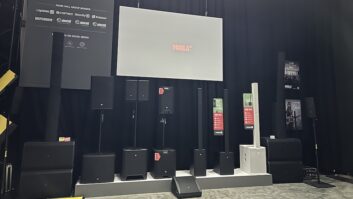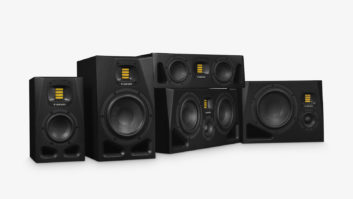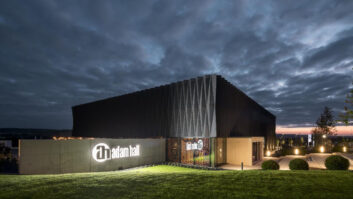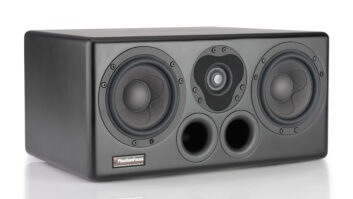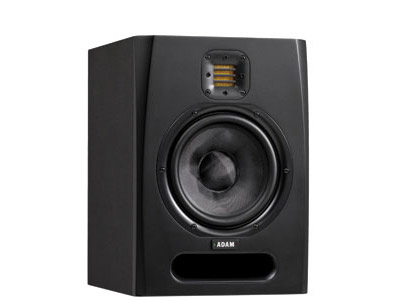
This German company started out in 1999 with strictly high-end offerings, which were endorsed by many high-profile audio engineers. That “high dollar, rarified air” club has been brought down into the realms of affordability, with several offerings in the home studio and project arena, all of which keep the philosophy of the air motion transformer tweeter design intact. This high-frequency transducer has characteristics all its own, which some engineers prefer. The ADAM F7 is the latest offering that breaks price barriers and delivers performance to the tabletop production environment that has been, in recent years, unobtainable in a speaker with this tiny of a footprint. Built for near-field environments, the F7 delivers reliable, linear response for home, project studios and editorial stations, at an affordable price point.
Pocket Rocket
The F7 is the larger of the two F Series speakers from ADAM, sporting a 7-inch combination Fiberglas/paper woofer, along with the characteristic air motion transformer tweeter (the same tweeter used in the more expensive A Series), all enclosed in a small-footprint 12.5H x 9W x 10.5D inches enclosure; perfect for tight spaces, desktop production and even remote recording. The front port is elongated, utilizing a molded plastic insert, with a “rounded edge” design to not only increase low-frequency response but also to reduce port turbulence and edge diffraction. This forward, front port makes it easy to mount the speakers in tight situations, such as broadcast trucks or near a wall, achieving a good, linear, low-end response without having to deal with the problems that can be encountered with a rear-port design in these situations. Frequency response is published as 44 Hz to 50 kHz; yes, the air motion transformer tweeter has an extended high-end reproduction.
Conventional Class-A/B amplifiers provide amplification, with 60W RMS going to the woofer and 40W RMS sent to the tweeter. This more conventional configuration adds a bit of weight (compared to the lighter Class-D amps), with each box weighing in at 19.8 pounds.
Tailored Response
On the back of the box, signals arrive at a balanced XLR or unbalanced RCA inputs. An input sensitivity control ranges from -∞ to +6 dB, allowing the amps to accept many different sources and levels. A high-shelf EQ, which starts at 5 kHz, has ±6 dB of cut/boost to tailor the response of the high end to your room. The low shelf activates at 300 Hz, with the same ±6dB characteristic. I found this to be useful in my room, attenuating the low end by approximately 1.5 dB to create a more linear reproduction, due to the front bass port. An 80Hz highpass filter rounds out the controls on the back panel, which can be inserted if you are using a subwoofer. (ADAM makes a matching “SubF,” which was not available at the time of this writing.) The crossover frequency is 2.6 kHz. No information is given about the design of the crossover, but the coupling characteristics of the two transducers sounds very smooth, with no apparent separation.
A speaker of this size begs the big questions: “Does it translate to other speaker systems? And, “How is the detail?” In other words, “Can I mix on these and be comfortable knowing that what I’m hearing is accurate?” I think we’ve all mixed on speakers that are “not quite accurate,” then endured the process of remixing or going back and “re-learning” our speakers. I can certainly say that this speaker has proven well for me; it matches up very well with my reference speakers, which cost four times as much, and having the opportunity to test them against another manufacturer’s ribbon tweeter design, I can say that they are close in response to speakers retailing for almost twice the price. What you lose is a minute amount of midrange response. This could translate into mixing the midrange hotter, or, a bit more forward to compensate, compared to your go-to mains. Again, at this price point (approximately $400/speaker), you are not going to get the clinical accuracy of an $8,000 (or $80,000!) speaker system. And a Ford is not going to respond like a Bugatti, but, you can learn this speaker and mix on it!
I’m Feeling Punchy
The low-end punch was exceptionally good—I elevated the levels using my reference audio (well-known mixes from many different genres, as well as my own original Pro Tools files), and found the imaging and soundstage to be well placed. The phantom center was solid, and the sweet spot was wider than I had anticipated. I was impressed with the air motion transformer tweeter response. The “ringing” that is sometimes associated with other designs was virtually non-existent. I found the air motion transformer tweeter to be smoother than other systems, even in the ADAM line itself. At low SPL levels, listening to detail and blend, the mix moved down accordingly, and accurately. With some speakers, there is a huge difference in accuracy of the mix levels at different SPL levels, say 105 vs. 65. The F7s held up very well from the “dance level” to the background levels.

While evaluating orchestral music, which can be extremely telling of speaker response and linearity, I found the soundstage to be accurate, and the blend of instruments to have very little phase-smear; the piccolos on the Bolshoi Theatre Orchestra’s rendition of “Beethoven’s 9th Symphony” were without coloration or resonance, a nod to the accurate reproduction characteristics of the air motion transformer tweeter. The “Flower Duet” from Lakmé brought the vocalists front and center, with distinct separation between the two female performers. The reproduction of Wagner’s “Prelude to Act III” of Lohengrin produced harmonic power to the string section that I’ve never quite witnessed in a speaker of this size and price point.
Electronica and EDM brought the synthesized bass and drums, along with the huge harmonic richness of solo synths, into the room with clarity and presence. Some of my favorite pop recordings (a tip of the hat to Mutt…) kept up with my reference speakers, with only the slightest dip in the vocal presence—a truly exceptional compliment to modern speaker design. Small speakers keep getting better and better.
Another good evaluation of a speaker is to launch your favorite orchestral Norwegian Death Metal and see how the guitars shift compared to your reference speakers. I can tell you, there was only a slight receding of the guitar tracks on the jaunty renditions by Dimmu Borgir—these speakers will work well with many different genres of music. The separation was not lost among the instruments of this particular genre, which can have a tendency to get crowded.
Conclusions
I have listened to many ADAM speakers over the past 15 years. As with other companies, some of the boxes I like, some not so much. Every speaker system takes some dialing in with placement, along with adjustment of your room acoustics. What impressed me regarding the F7s was not only the performance vs. price point, but also the clarity of reproduction and the separation of instrumentation—important characteristics in any speaker design.
You will be able to track and mix, knowing that what you are hearing can translate to other speaker systems (presuming you have true, accurate room acoustics). The air motion transformer tweeter design is an effective and more efficient way of reproducing high frequencies, but as every engineer will tell you, each tweeter design sounds different. Be it a silk dome, titanium, beryllium or ribbon, you have to find the top-end transducer that you can work with, bringing home a mix that translates to many other speaker systems. I can attest that this is “the little speaker that could….” At this price point, the ADAM F7s are definitely worth your time to give a listen.
Bobby Frasier is an engineer, musician and writer who knows almost everything about The Beatles.
Product Summary
COMPANY: ADAM Audio
PRODUCT: F7 Monitors
WEBSITE:www.adam-audio.de
PRICE: $449 each
PROS: Sound great (read: accurate)! Small footprint, smooth response between tweeter and woofer, plenty of power, extremely affordable, accurate response, user adjustments, front-ported for punchy low-end response.
CONS: No VESA mounts, no networking, no variable bell EQ for tabletop adjustments, no digital inputs, will need a subwoofer for the lower octave.
TRY THIS
Most home and project studio workstations (furniture) have a bridge, which is a convenient place to mount your speakers but not the best place to achieve accurate reproduction. Get some speaker stands and get those speakers out, away from the big reflective surfaces. Best case would be to put your speakers behind the desk, get them up in the air, and point them toward a point at the back of your head. This will give you a direct radiation of the sound, with the temporal fusion associated with your first big early reflection coming off of your desk virtually eliminated. With less bounce, there will be less phase-related issues.
